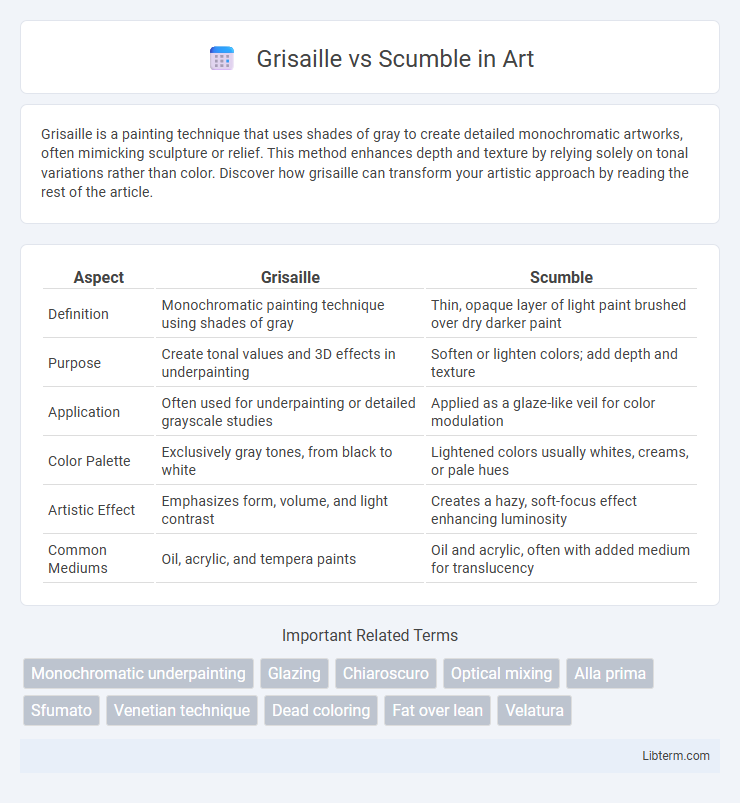Grisaille is a painting technique that uses shades of gray to create detailed monochromatic artworks, often mimicking sculpture or relief. This method enhances depth and texture by relying solely on tonal variations rather than color. Discover how grisaille can transform your artistic approach by reading the rest of the article.
Table of Comparison
| Aspect | Grisaille | Scumble |
|---|---|---|
| Definition | Monochromatic painting technique using shades of gray | Thin, opaque layer of light paint brushed over dry darker paint |
| Purpose | Create tonal values and 3D effects in underpainting | Soften or lighten colors; add depth and texture |
| Application | Often used for underpainting or detailed grayscale studies | Applied as a glaze-like veil for color modulation |
| Color Palette | Exclusively gray tones, from black to white | Lightened colors usually whites, creams, or pale hues |
| Artistic Effect | Emphasizes form, volume, and light contrast | Creates a hazy, soft-focus effect enhancing luminosity |
| Common Mediums | Oil, acrylic, and tempera paints | Oil and acrylic, often with added medium for translucency |
Grisaille vs Scumble: Key Differences
Grisaille involves painting in monochromatic shades of gray to create a detailed underpainting or a finished artwork that emphasizes form and volume through tonal contrast. Scumble is a painting technique where a thin, opaque layer of lighter or contrasting color is brushed over a darker, dried layer to soften and modify its appearance, creating a hazy or textured effect. The key difference lies in Grisaille's focus on grayscale tonal modeling to establish depth, while Scumble modifies color and texture by layering translucent or semi-opaque paint to achieve atmospheric effects.
Understanding Grisaille Technique
Grisaille is a painting technique that uses shades of gray to create a monochromatic underpainting, emphasizing form and volume through tonal values rather than color. This method helps artists establish the composition's structure and light dynamics before applying layers of color, enhancing depth and realism. Unlike scumbling, which involves applying a thin, opaque layer of paint to soften or lighten areas, grisaille serves as the foundational grayscale framework for subsequent glazing or color washes.
Exploring the Art of Scumbling
Scumbling is a glazing technique that involves applying a thin, opaque layer of paint to create texture and soften underlying colors, enhancing depth in a composition. Unlike Grisaille, which uses monochromatic tones to establish values and forms, scumbling introduces subtle color variations and atmospheric effects through transparent or semi-opaque layers. Artists leverage scumbling to add luminosity and a sense of movement, making it a dynamic tool in realism and impressionism.
Historical Origins of Grisaille
Grisaille is a monochromatic painting technique that dates back to the Middle Ages, originating in illuminated manuscripts and stained glass windows to mimic sculpture through shades of gray. This method was widely used during the Renaissance to create underpaintings and detailed architectural illusions, providing depth and form before applying color. In contrast, scumbling, which emerged later during the Baroque period, involves lightly layering opaque or semi-opaque colors to produce a softer, textured effect over dry paint layers.
Scumble in Art History
Scumble is a painting technique involving the application of a thin, semi-transparent layer of lighter paint over a darker underlayer to create a soft, muted effect and enhance texture. In art history, scumbling became prominent during the Renaissance and Baroque periods, used by masters like Rembrandt to achieve depth and atmospheric subtlety in oil paintings. Grisaille, in contrast, involves monochromatic painting to simulate sculpture or create underpaintings, while scumble emphasizes tonal modulation and light diffusion.
Materials and Tools for Grisaille
Grisaille painting primarily uses monochromatic pigments, such as shades of gray, black, or brown, often applied with fine brushes to achieve detailed tonal gradations. Artists commonly employ oil paint or acrylics on primed surfaces like canvas or wood panels to create the illusion of sculpture through light and shadow. Essential tools include soft brushes for smooth blending and palette knives for textural effects, ensuring precise control over the subtle value changes integral to the grisaille technique.
Essential Supplies for Scumbling
Scumbling requires essential supplies such as stiff-bristled brushes, opaque paints, and a textured canvas to create its characteristic broken or hazy effect. Artists often use dry, semi-dry brushes loaded with minimal paint to gently add layers over a dried base, enhancing texture and depth. Choosing the right transparency in paints, mainly oil or acrylic, is crucial for achieving the soft blending and subtle transitions intrinsic to effective scumbling.
Step-by-Step: Grisaille Process
Grisaille is a painting technique that uses monochromatic shades of gray to establish values and forms before applying color layers, enhancing depth and realism. The step-by-step process of Grisaille begins with sketching the composition, followed by applying an underpainting in varying gray tones to define light and shadow accurately. Once the grayscale foundation is complete and dry, artists layer transparent glazes of color to achieve a luminous, three-dimensional effect.
Step-by-Step: Scumbling Process
Scumbling involves lightly dragging a thin, semi-opaque layer of paint over a dry base layer to create texture and subtle color shifts, enhancing depth and luminosity in a painting. Begin by choosing a dry, matte underpainting as your base, then load a dry brush with a small amount of lighter or contrasting paint, and gently scrub or sweep it over the surface to allow the underlayer to show through selectively. This step-by-step layering promotes a soft, broken effect distinct from the monochromatic Grisaille method, which focuses on tonal values using a single color palette.
Choosing Between Grisaille and Scumble
Choosing between grisaille and scumble depends on the desired painting effect and technique. Grisaille involves creating a monochromatic underpainting to establish tonal values and structure before applying color, ideal for detailed and controlled compositions. Scumble uses a thin, opaque layer of lighter paint to soften or modify colors, perfect for adding texture and enhancing light effects in a more spontaneous manner.
Grisaille Infographic

 libterm.com
libterm.com